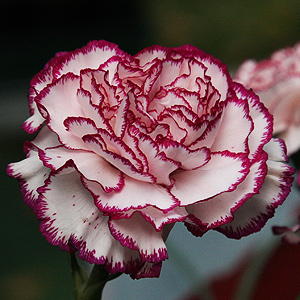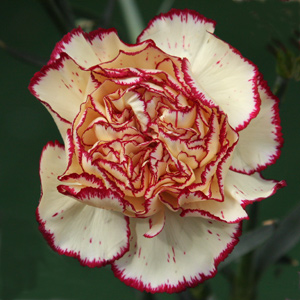
Carnations are a garden favourite and are relatively easy to grow from cuttings. They are an excellent plant for growing in pots as well as being at home in the garden. Difficult to grow indoors, however they do thrive outside. The flowers can be single colored or ruffled (see picture right).
A flowering perennial plant that grow well is full sun, with a little protection from hot afternoon sun if possible. You can grow carnations from seed however we recommend growing from cuttings or plugs.
They require a well drained humus rich soil with a neutral ph and are an excellent plant for a raised garden bed or a large pot or container.
Carnation plants are actually fairly hardy and do not require a lot of water, and resent over watering, a good soaking once a week, or twice a week in hot conditions is usually enough.
How to Propagate Carnations

The easiest method of propagation is by taking cuttings, and the best time to do this is in mid summer. The part of the plant that you are looking for is the terminal tips, the top part of the stem.
- Wait until the plants have finished flowering, and look for non flowering stems.
- The cuttings need to be around 4 – 6 inches long.
- Remove the lower foliage and dip the lower end of the stem into a rooting hormone.
- You can then put the cuttings into some propagation mix or ordinary potting mix.
- Make a hole with a pencil put the cutting about 2 inches into the hole and firm around it.
- Water in with a liquid seaweed fertilizer.
- You can put a number of cuttings in the one pot.
- You can place a clear plastic bag over the pot to help maintain humidity.
- Keep the cuttings moist, in a warm but not hot position.
- Cuttings will strike in around 4 – 6 weeks, this is evident by new growth.
- Leave them in the pot until the root system has developed, they are then ready to plant out.
Care
- Fertilize carnations with an all purpose liquid or slow release fertilizer, we use a combination of a seaweed fertilizer and a slow release fertilizer.
- When planting avoid mulch as carnations like good air circulation around the stems. Plant about 10cm apart for healthy growth
- When pruning back or cutting flowers remove then at a node as close to the base as possible.
- For prolonged life in a vase try a little cut flower preservative, available from florists, or use a little household bleach and some sugar and change the water every 3 days.
Problems
- Snails and slugs can be a problem with new carnation shoots, so try keeping the area around plants clear.
For an organic solution, try spreading some wood ash, dried crushed eggshells or coffee grounds on the soil, or even a little grit, snails and slugs do not like to crawl over these.
Carnation Varieties
In terms of varieties carnations come in three types all come from Dianthus species.
Border Carnations
Although they are the oldest form in cultivation we see many new hybrids that will reach around 1.5 – 2 ft tall. They are from the species D. caryophyllus and are known as ‘pinks’. Border carnations have the large flowers and are scented and come in a huge range of colors from white through pink to deep red.
Annual Carnations
These are highly hybridised forms, and although they are called ‘annuals’ they are actually perennials like all of the Dianthus. However the long flowering habit that has been bred into them causes them to be a little difficult to over winter, especially in colder climates. By the end of the season they are exhausted.
Perpetual Carnations
These are the ‘new carnations’ a hybrid between D. caryophyllus and D. sinensis, best known for the Sim Carnation, a type used widely for cut flowers, its long stems are sturdy and the flowers are large, but not scented. One of the ‘Top Ten’ cut flowers in the world.

